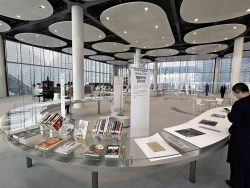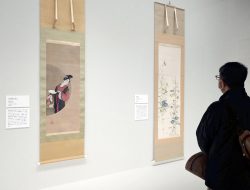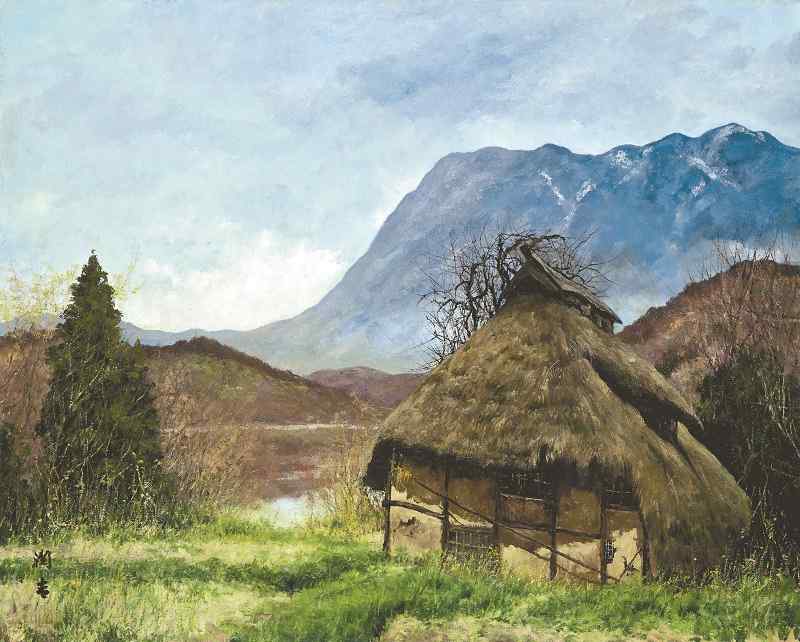
“The Chikuma River after a Rain Storm” (1977) by Junkichi Mukai, oil on canvas, 80.4 by 100 centimeters (in the collection of the Setagaya Art Museum).
14:35 JST, September 2, 2021
An old Japanese building with a thatched roof stands amid the moist air after a rainstorm. Looking like a barn or an abandoned home, its rustic appearance blends beautifully with the surrounding natural landscape in the oil painting “Ugo Chikumagawa” (The Chikuma River after a Rain Storm)” by Junkichi Mukai (1901-95).
Mukai was a Western-style painter who depicted minka traditional houses across the country throughout the latter half of his career, leaving behind archetypal images of Japan.
When creating these pieces, Mukai also subtitled them with their locations. From the subtitle “Toyotsu Hazama, Toyota Village, Shimominochi Country, Nagano Prefecture,” for example, we know that “The Chikuma River after a Rain Storm” depicts a village in Nagano Prefecture overlooking the Chikumagawa river.
“I’ve been there myself, but there weren’t any minka houses still standing and the area’s name had changed,” said Yoshiya Hashimoto, 61, vice director and chief curator of the Setagaya Art Museum, which owns the painting.
Mukai usually created his minka paintings on an easel at each location, but the large Chikumagawa piece was done in his studio, with the intention of presenting it at an exhibition.
A smaller version also exists, along with a photo taken from the same angle at the site. When compared side by side, visitors can see the paintings aren’t exact depictions of the area. The utility poles and car in the photo aren’t in the paintings, for example, and the shape of both the house’s roof and the mountain are also different.
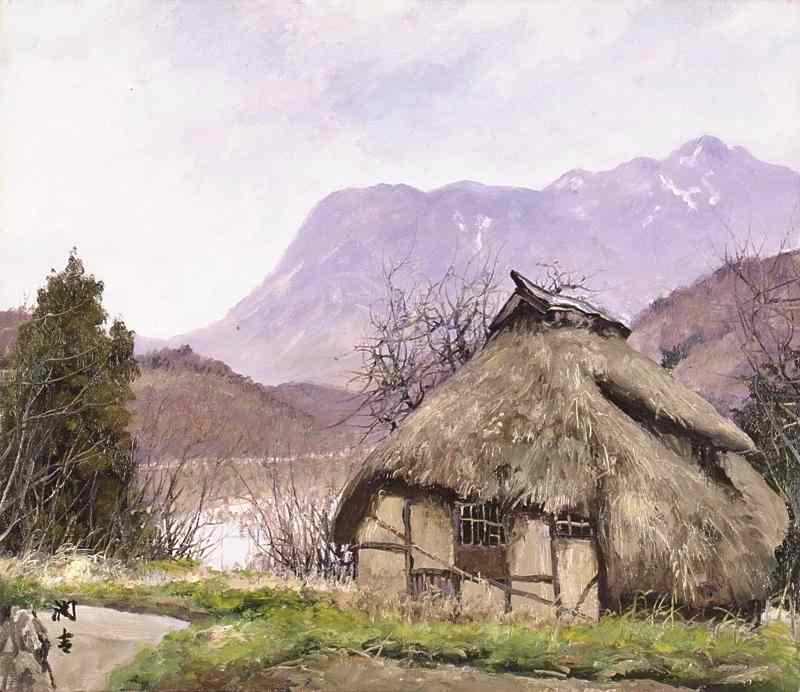
“The Chikuma River after a Rain Storm” (1977) by Junkichi Mukai, 45.5 by 53 centimeters (in the collection of the Setagaya Art Museum), which was created on the site. The shape of the roof differs from that in the larger work.
Hashimoto, who knew Mukai personally, said the artist kept meticulous records and took more than 20,000 photos on his trips. Because he painted on-site, the photos were only for his records. Mukai showed very few of these photos to others during his life, perhaps to prevent his work style from being misunderstood. After his death, it became possible to study his artistic intentions by comparing his photos with the paintings.
One of the things I learned from Hashimoto about the paintings is the different ways the mountain is depicted.
“The mountain comes into view earlier than one would expect when viewing it from the train that runs along the river. As the train moves, the angle at which the mountain is viewed changes, making it look as though its shape is changing. I believe this changing shape was on Mukai’s mind when he painted the mountain.”
The painter did his best to depict the landscapes of the minka houses as he saw them through his mind’s eye. Just what was on his mind at that time?
A native of Kyoto, Mukai studied in France prior to World War II. During the war, he cooperated with the military and created war paintings. He also went to Burma and the Imphal front as a military painter, along with the writer Ashihei Hino and the composer Yuji Koseki.
As Japan’s defeat became increasingly certain, Mukai “became suddenly and deeply attached to minka houses,” he later wrote.
He did his first minka painting in Niigata Prefecture, where he had gone to collect his eldest daughter, who had been evacuated during the war. From that point on, as if racing against time, he did many paintings of minka houses, which were disappearing due to rapid economic growth and land development.
“I think he did so with a sense of duty in a way,” Hashimoto said. “The war caused the loss of many lives and well-being. In contrast, Mukai felt that minka houses were symbolic of a peaceful life, I think.”
Hashimoto said with a laugh: “He didn’t paint luxurious minka houses. If he had, his paintings would have sold better.”
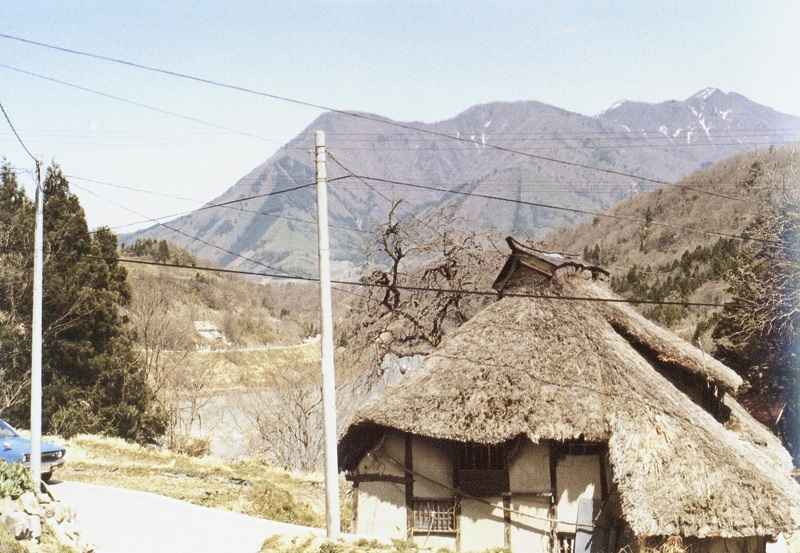
A photo taken in 1977 (in the collection of the Setagaya Art Museum) of the place depicted in “The Chikuma River after a Rain Storm” shows utility poles and a car.
Mukai annex exhibition
Gosuke Ikejiri, 40, a curator of the museum, said, “There’s still much work to be done when it comes to interpreting and understanding the materials left by Mukai,” indicating that this was a task he’d inherited from a more veteran curator.
After Ikejiri told me that he sometimes uses Google’s Street View service to find places Mukai visited to paint local landscapes, I decided to do some research of my own. I’ve found that many of the minka houses Mukai painted no longer exist, leaving behind only peaceful rural landscapes.
Mukai had his home and studio remodeled into a museum at his own expense and donated it to Setagaya Ward, Tokyo, along with several of his works. The building was opened as the Mukai Junkichi Annex at the Setagaya Art Museum in 1993.
A two-part exhibition commemorating the 120th anniversary of Mukai’s birth is being held at the annex.
“The Chikuma River after a Rain Storm” is among the items on display in the exhibition’s first part, titled “Commemorating the 120th Anniversary of the Artist’s Birth: The Life and Work of Mukai Junkichi Including the Artist’s Designs.”
The first half is scheduled to run through Sept. 26. The second part will run from Oct. 16 to March 13, 2022, and feature an entirely different lineup of works.
The Kitakata City Museum of Art in Fukushima Prefecture is also slated to hold an exhibition of the Setagaya Art Museum’s Mukai collection from Sept. 18 to Nov. 3 containing 45 works, mainly paintings of minka houses in the Tohoku region and Niigata Prefecture.
"Culture" POPULAR ARTICLE
-

Van Cleef & Arpels Dazzles with Art Deco Artisanry at Tokyo Exhibit
-

Disney’s ‘Twisted-Wonderland’ Animated Series Puts Villains in Spotlight: New Show Features School Inspired by Classic Disney Films
-

Ayumi Hamasaki’s Shanghai Concert Canceled Day Before Schedule as Part of Beijing Backlash
-

‘The World Masterpiece Theater Series’ Celebrates 50 Years; Animator Looks Back on Creating Anime Classics
-
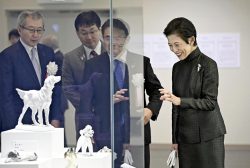
Exhibition Featuring Dog Figurines Donated by Princess Hisako of Takamado Opens in Aichi Prefecture; Princess Attends Ahead of Opening
JN ACCESS RANKING
-

Tokyo Economic Security Forum to Hold Inaugural Meeting Amid Tense Global Environment
-

Keidanren Chairman Yoshinobu Tsutsui Visits Kashiwazaki-Kariwa Nuclear Power Plant; Inspects New Emergency Safety System
-

Imports of Rare Earths from China Facing Delays, May Be Caused by Deterioration of Japan-China Relations
-

University of Tokyo Professor Discusses Japanese Economic Security in Interview Ahead of Forum
-

Japan Pulls out of Vietnam Nuclear Project, Complicating Hanoi’s Power Plans


